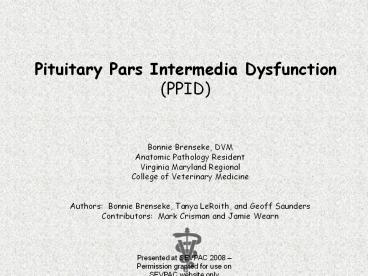Pituitary Pars Intermedia Dysfunction (PPID) - PowerPoint PPT Presentation
1 / 18
Title:
Pituitary Pars Intermedia Dysfunction (PPID)
Description:
Pituitary Pars Intermedia Dysfunction (PPID) Bonnie Brenseke, DVM Anatomic Pathology Resident Virginia Maryland Regional College of Veterinary Medicine – PowerPoint PPT presentation
Number of Views:120
Avg rating:3.0/5.0
Title: Pituitary Pars Intermedia Dysfunction (PPID)
1
Pituitary Pars Intermedia Dysfunction (PPID)
- Bonnie Brenseke, DVM
- Anatomic Pathology Resident
- Virginia Maryland Regional
- College of Veterinary Medicine
- Authors Bonnie Brenseke, Tanya LeRoith, and
Geoff Saunders - Contributors Mark Crisman and Jamie Wearn
2
Kibbles
not really Kibbles, hoofcare.blogspot.com
3
For the washer/dryer and free trip to Hawaii
- Classic case of PPID/Equine Cushings Syndrome
- Common endocrine disorder of aged horses and
ponies - Etiology and pathophysiology?
- -primary lesion of the pituitary gland
- -loss of dopaminergic inhibition on the pars
intermedia
www.saatchi-gallery.co.uk
www.hawaiiguide.com
4
Anatomy
Banks, William. Applied Veterinary Histology.
Baltimore, MD Williams Wilkins, 1981.
5
Pathogenesis
6
Clinical Signs? due to hormone dysregulation to
space-occupying effects
- Hypertrichosis (Hirsutism)- almost pathognomonic
- Hyperhydrosis
- Laminitis
- Polyuria/Polydipsia
- Polyphagia
- ?ed susceptibility to infections (skin, lung,
parasites)
7
Clinical signs contd
- Behavioral changes-docility, lethargy, narcolepsy
- Muscle wasting- pendulous abdomen, sway back
- Fat redistribution- bulging supraorbital fat
pads, cresty neck, fat accumulation around
tailhead - Infertility
www.lazyhorserescue.org
8
Diagnostics
- CBC/Chem/UA
- Dexamethasone Suppression Test (DST)-fail to
suppress cortisol (gt 1µg/dl) - ACTH levels- gt50pg/ml in horses and gt27pg/ml in
ponies supports diagnosis - Baseline cortisol concentrations
- Urinary corticoid/creatinine ratio
- ACTH stimulation test
- Combined DST and ACTH stimulation test
- Thyrotropin-releasing hormone (TRH) stimulation
test - Combined DST and TRH stimulation test
- Resting insulin concentrations
- Glucose tolerance test
- Insulin tolerance test
- Imaging
9
Treatment
- Dopamine agonists
- Pergolide and Bromocriptine
- Serotonin antagonist
- Cyproheptadine
- Supplements
- Magnesium chromium picolinate
- Vitex (chasteberry extract, V.
agnus-castus) - Treat all pathologic conditions (i.e., laminitis
infections)
www.smartpakequine.com
10
Necropsy findings
11
(No Transcript)
12
(No Transcript)
13
Histopathology
Pituitary Adenoma
14
Miller, M.A., I.D. Pardo, L.P. Jackson, G.E.
Moore and J.E. Sojka. Correlation of Pituitary
Histomorphometry with Adrenocorticotrophic
Hormone Response to Domperidone Administration
in the Diagnosis of Equine Pituitary Pars
Intermedia Dysfunction. Veterinary Pathology 45
(2008) 26- 38.
15
Ultrastructural Findings
16
References
- 1. Banks, William. Applied Veterinary Histology.
Baltimore, MD Williams Wilkins, 1981. - 2. Capen, Charles. Tumors of the Endocrine
Glands. Tumors in Domestic Animals. - Ed. Donald Meuten. Ames, IA Iowa
State Press, 2002. 616-620. - 3. McFarlane, D., M.T.Donaldson, T.M. Saleh and
A.E. Cribb. The Role of - Dopaminergic Neurodegeneration in Equine
Pituitary Pars Intermedia Dysfunction - (Equine Cushings Disease). Proceedings
of the 49th Annual Convention of the - American Association of Equine
Practitioners, New Orleans, Louisiana, USA, 21-25
- November 2003. Internet Publisher
International Veterinary Information Service. - 4. Miller, M.A., I.D. Pardo, L.P. Jackson, G.E.
Moore and J.E. Sojka. Correlation of - Pituitary Histomorphometry with
Adrenocorticotrophic Hormone Response to - Domperidone Administration in the
Diagnosis of Equine Pituitary Pars Intermedia - Dysfunction. Veterinary Pathology 45
(2008) 26- 38. - 5. Toribio, Ramiro. Pars Intermedia Dysfunction
(Equine Cushings Disease). Equine - Internal Medicine. Ed. Liz Fathman. St.
Louis, MN Saunders, 2004. 1327-1338.
17
BIG Thanks to
- Pathologists Drs. Tanya LeRoith Geoff
Saunders - Equine Clinicians Drs. Mark Crisman Jamie
Wearn - Resident Mates Drs. Natalie Durrett, Anya
Hawthorn, Ron Tyler - Histology Laboratory Technicians Barbara
Wheeler, Jill Songer, Luther Vest - Morphology Laboratory Manager Kathy Lowe
- Media Jerry Baber
18
QUESTIONS?
Go Pack!
Go Hokies!





























![[PDF] INTERSTITIAL CYSTITIS DIET COOKBOOK 2023: Easy, Healthy, and Mouth-Watering Recipes for Healing Pelvic Pain and Bladder Dysfunction Paperback – July 8, 2023 Android PowerPoint PPT Presentation](https://s3.amazonaws.com/images.powershow.com/10078409.th0.jpg?_=20240713099)

![[PDF] Pedretti's Occupational Therapy: Practice Skills for Physical Dysfunction (Occupational Therapy Skills for Physical Dysfunction (Pedretti)) 7th Edition Full PowerPoint PPT Presentation](https://s3.amazonaws.com/images.powershow.com/10085968.th0.jpg?_=20240726025)